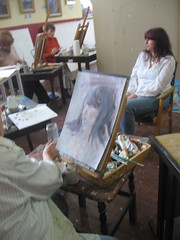Last night, I happened to catch a show that included a brief trip to the Académie Julian. The documentary was retracing the footsteps of some Americans who studied art there. (The Académie no longer exists, because it merged with ESAG Penninghen in 1968, but they still offer classes in the same buildings.)
 The administrator they interviewed, an older man well-versed in school history, took the interviewer to the studios where her subjects would have studied in the 1890s, and explained how classes were conducted. The masters here actually corrected their students’ art on right on the canvas. As the administrator pointed out, this was a far more effective way of learning than just sitting listening to lectures—they got to see how to change what they were doing to get something better.
The administrator they interviewed, an older man well-versed in school history, took the interviewer to the studios where her subjects would have studied in the 1890s, and explained how classes were conducted. The masters here actually corrected their students’ art on right on the canvas. As the administrator pointed out, this was a far more effective way of learning than just sitting listening to lectures—they got to see how to change what they were doing to get something better.
I think this is probably one of the reasons I’ve enjoyed taking Margie Lawson‘s live class on Empowering Character Emotions so much—while the lectures I’ve read are overwhelmingly informative and have really changed the way I look at writing characters’ emotions, the hands-on help from the instructor might make the biggest difference. She helps us fine-tune our writing (albeit in small samples) to add just the right amount of power.
No, there’s no one instructor that you can follow to guarantee publication (unless that instructor works for a publishing company that’s offering you a contract along with that guidance 
What do you think? When do you find hands-on most helpful?
Photo by Andrew Crummy


I learn something every time someone has some hands-on interaction with my work. That’s one reason I like the LDStorymakers boot camp so much.
I prefer to mess with other people’s work. Whenever someone touches mine it doesn’t feel right.